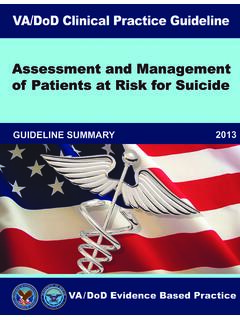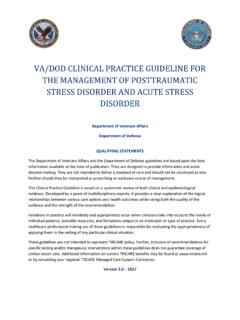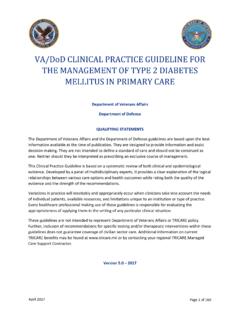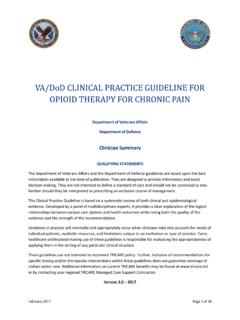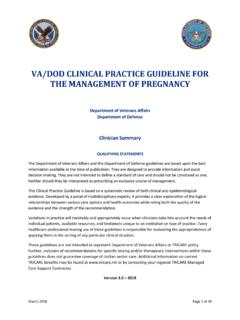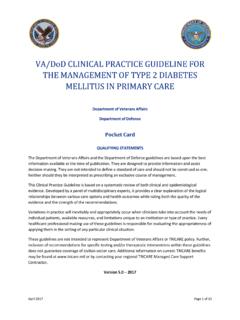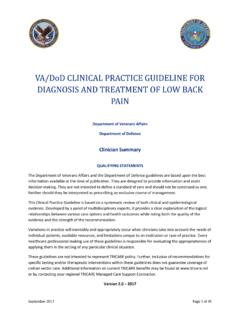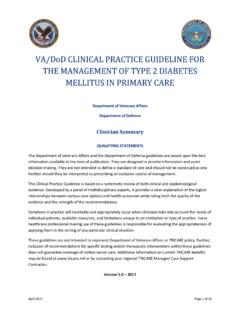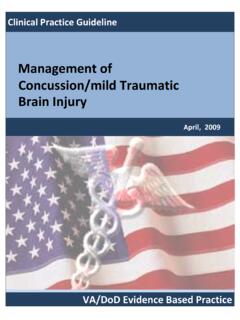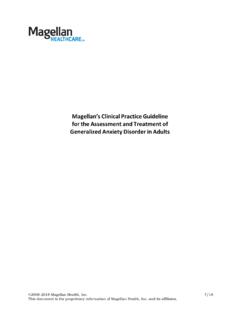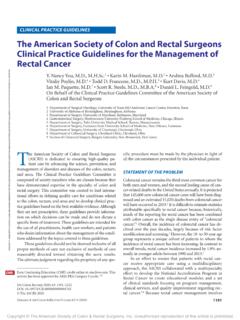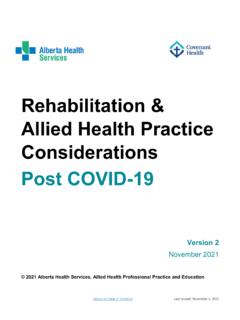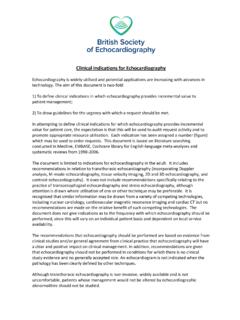Transcription of VA/DoD Clinical Practice Guideline for the Management of ...
1 VA/DoD Clinical Practice Guideline FOR THE Management OF CHRONIC INSOMNIA DISORDER AND OBSTRUCTIVE SLEEP APNEA Department of Veterans Affairs Department of Defense QUALIFYING STATEMENTS The Department of Veterans Affairs and the Department of Defense guidelines are based upon the best information available at the time of publication. They are designed to provide information and assist decision making. They are not intended to define a standard of care and should not be construed as one. Neither should they be interpreted as prescribing an exclusive course of Management . This Clinical Practice Guideline is based on a systematic review of both Clinical and epidemiological evidence. Developed by a panel of multidisciplinary experts, it provides a clear explanation of the logical relationships between various care options and health outcomes while rating both the quality of the evidence and the strength of the recommendation.
2 Variations in Practice will inevitably and appropriately occur when clinicians take into account the needs of individual patients, available resources, and limitations unique to an institution or type of Practice . Every healthcare professional making use of these guidelines is responsible for evaluating the appropriateness of applying them in the setting of any particular Clinical situation. These guidelines are not intended to represent Department of Veterans Affairs or TRICARE policy. Further, inclusion of recommendations for specific testing and/or therapeutic interventions within these guidelines does not guarantee coverage of civilian sector care. Additional information on current TRICARE benefits may be found at or by contacting your regional TRICARE Managed Care Support Contractor.
3 Version 2019VA/DoD CPG for the Management of Chronic Insomnia Disorder and Obstructive Sleep Apnea October 2019 Page 2 of 152 Prepared by: The Management of Chronic Insomnia Disorder and Obstructive Sleep Apnea Work Group With support from: The Office of Quality, Safety and Value, VA, Washington, DC & Office of Evidence Based Practice , Army Medical Command Version 2019 Based on evidence reviewed through May 2018 VA/DoD CPG for the Management of Chronic Insomnia Disorder and Obstructive Sleep Apnea October 2019 Page 3 of 152 Table of Contents I. Introduction .. 6 II. 6 A. Definitions and Scope .. 6 a. Chronic Insomnia Disorder .. 6 b. Obstructive Sleep 7 B. Epidemiology and Impact in the General Population .. 7 C. Sleep Disorders in the Department of Defense and the Department of Veterans Affairs Populations.
4 8 a. Agenda for Increased Access to Behavioral Interventions for Insomnia Disorder .. 8 b. Agenda for Increased Access to Mandibular Advancement Device Therapy for Indicated Active Duty Service Members and Veterans .. 9 III. About this Clinical Practice Guideline .. 10 A. Methods .. 10 a. Grading Recommendations .. 11 b. Peer Review Process .. 12 B. Summary of Patient Focus Group Methods and Findings .. 13 C. Conflicts of Interest .. 14 D. Scope of this Clinical Practice Guideline .. 14 E. Highlighted Features of this Clinical Practice Guideline .. 15 F. Patient-centered Care .. 15 G. Shared Decision Making .. 16 H. Co-occurring Conditions .. 16 I. Implementation .. 16 IV. Guideline Work Group .. 18 V. Algorithm .. 19 Module A: Screening for Sleep Disorders.
5 20 Module B: Management of Chronic Insomnia Disorder .. 22 Module C: Management of Obstructive Sleep Apnea .. 25 VI. Recommendations .. 27 A. Diagnosis and Assessment of Obstructive Sleep Apnea and Insomnia Disorder .. 30 B. Treatment and Management of Obstructive Sleep Apnea .. 36 VA/DoD CPG for the Management of Chronic Insomnia Disorder and Obstructive Sleep Apnea October 2019 Page 4 of 152 C. Treatment and Management of Chronic Insomnia Disorder .. 48 a. Behavioral and Psychological Treatments .. 48 b. Complementary and Integrative Health Treatments .. 55 c. Over-the-counter Treatments .. 59 d. Pharmacotherapy .. 64 D. Knowledge Gaps and Recommended Research .. 72 a. Chronic Insomnia Disorder .. 72 b. Obstructive Sleep 74 Appendix A: Evidence Review Methodology.
6 77 A. Developing the Key Questions .. 77 a. Population(s) .. 78 b. Interventions .. 78 c. Comparators .. 82 d. Outcomes .. 83 B. Conducting the Systematic Review .. 85 a. General Criteria for Inclusion in Systematic Review .. 89 b. Key Question Specific Criteria .. 89 C. Convening the Face-to-face Meeting .. 90 D. Grading Recommendations .. 90 E. Recommendation Categorization .. 94 a. Recommendation Categories and Definitions .. 94 b. Categorizing Recommendations .. 95 F. Drafting and Submitting the Final Clinical Practice 95 Appendix B: Provider Guide to Sleep Education for Insomnia Disorder .. 97 A. General Information on Insomnia Disorder .. 97 B. Goals of Insomnia Treatment .. 97 C. Describing CBT-I and BBT-I to Patients .. 98 D. Examples of Supporting Self- Management Goals Related to the Stimulus Control and Sleep Restriction Components of CBT-I/BBT-I.
7 98 Appendix C: Provider Guide to Sleep Education for Obstructive Sleep Apnea .. 99 A. General Information on Obstructive Sleep Apnea .. 99 B. Diagnosing Sleep Apnea: Sleep Studies .. 99 C. Describing Sleep Apnea Treatment to Patients .. 99 D. Other Areas that Can Make Sleep Apnea Better or Worse .. 100 E. Addressing Sleepiness .. 100 F. Addressing Adherence to Positive Airway Pressure .. 100 VA/DoD CPG for the Management of Chronic Insomnia Disorder and Obstructive Sleep Apnea October 2019 Page 5 of 152 Appendix D: ICSD-3 Diagnostic Criteria .. 101 A. Chronic Insomnia Disorder .. 101 a. Alternate Names .. 101 b. Diagnostic Criteria .. 101 B. Obstructive Sleep Apnea .. 102 a. Alternate Names .. 102 b. Diagnostic Criteria .. 102 Appendix E: ISI and STOP Questionnaire Scoring Criteria.
8 103 A. ISI .. 103 B. STOP Questionnaire .. 104 Appendix F: DoD and VA Training in Behavioral Therapies for Insomnia Disorder .. 105 Appendix G: Patient Focus Group Methods and Findings .. 107 A. Methods .. 107 B. Patient Focus Group Findings .. 107 Appendix H: Evidence Table .. 109 Appendix I: Participant List .. 114 Appendix J: Literature Review Search Terms and Strategy .. 116 A. Syntax .. 116 a. 116 b. Obstructive Sleep 120 B. MEDLINE Syntax .. 124 a. 124 b. Obstructive Sleep 128 C. PsycINFO with Ovid Syntax .. 132 a. 132 b. Obstructive Sleep 136 Appendix K: Alternative Text Descriptions of Algorithms .. 137 Module A: Screening for Sleep Disorders .. 137 Module B: Management of Chronic Insomnia Disorder .. 137 Module C: Management of Obstructive Sleep Apnea.
9 138 Appendix L: Abbreviation List .. 140 References .. 143 VA/DoD CPG for the Management of Chronic Insomnia Disorder and Obstructive Sleep Apnea October 2019 Page 6 of 152 I. Introduction The Department of Veterans Affairs (VA) and Department of Defense (DoD) Evidence-Based Practice Work Group (EBPWG) was established and first chartered in 2004, with a mission to advise the Health Executive Committee (HEC) ..on the use of Clinical and epidemiological evidence to improve the health of the across the Veterans Health Administration (VHA) and Military Health System (MHS), by facilitating the development of Clinical Practice guidelines (CPGs) for the VA and DoD populations.[ 1] This CPG is intended to provide healthcare providers with a framework by which to evaluate, treat, and manage the individual needs and preferences of patients with sleep disorders, specifically chronic insomnia disorder and obstructive sleep apnea (OSA), thereby leading to improved Clinical outcomes.
10 An effort to create the Chronic Insomnia Disorder and OSA CPG was initiated in 2018. The Chronic Insomnia Disorder and OSA CPG includes objective, evidence-based information on the Management of selected sleep disorders ( chronic insomnia disorder and OSA). It is intended to assist healthcare providers in all aspects of patient care, including, but not limited to, screening, assessment, treatment, and follow-up. The system-wide goal of evidence-based guidelines is to improve patient health and well-being by guiding health providers who are taking care of patients with chronic insomnia disorder and/or OSA along Management pathways that are supported by evidence. The expected outcome of the successful implementation of this Guideline is to: Assess patient condition and determine, in collaboration with the patient, the best treatment method(s) Optimize patient health outcomes and improve quality of life Minimize preventable complications and morbidity Emphasize the use of patient-centered care (PCC) II.
